Abstract
The production of vascular permeability factor (PF) by certain strains of Pseudomonas aeruginosa has been demonstrated in rabbits injected intradermally with culture filtrates followed by intravenous injection with Pontamine Sky Blue 6BX. The dose-response curve was found to be rectilinear when lesion diameters, within the range of 10 to 20 mm, were plotted against log dose. Thus, PF in test filtrates can be measured with reasonable accuracy by the concomitant testing of a reference PF. In contrast to the titers of PF obtained with Vibrio cholerae cultures, those with strains of P. aeruginosa were rather low. Thus far, PF has been demonstrated only in shallow still cultures of P. aeruginosa and not in shake cultures. A variety of commercial media were tested for the production of PF, but none was satisfactory. A synthetic medium that gave more reproducible and higher yields of PF was developed. Cultivation at 30 C generally gave higher yields of PF than at 37 C. PF was destroyed by heating at 60 C for 30 min or by digesting with trypsin or Pronase. Strains producing larger amounts of PF appeared to have greater virulence when inoculated onto the surface of burns in mice than those yielding little or no PF.
Full text
PDF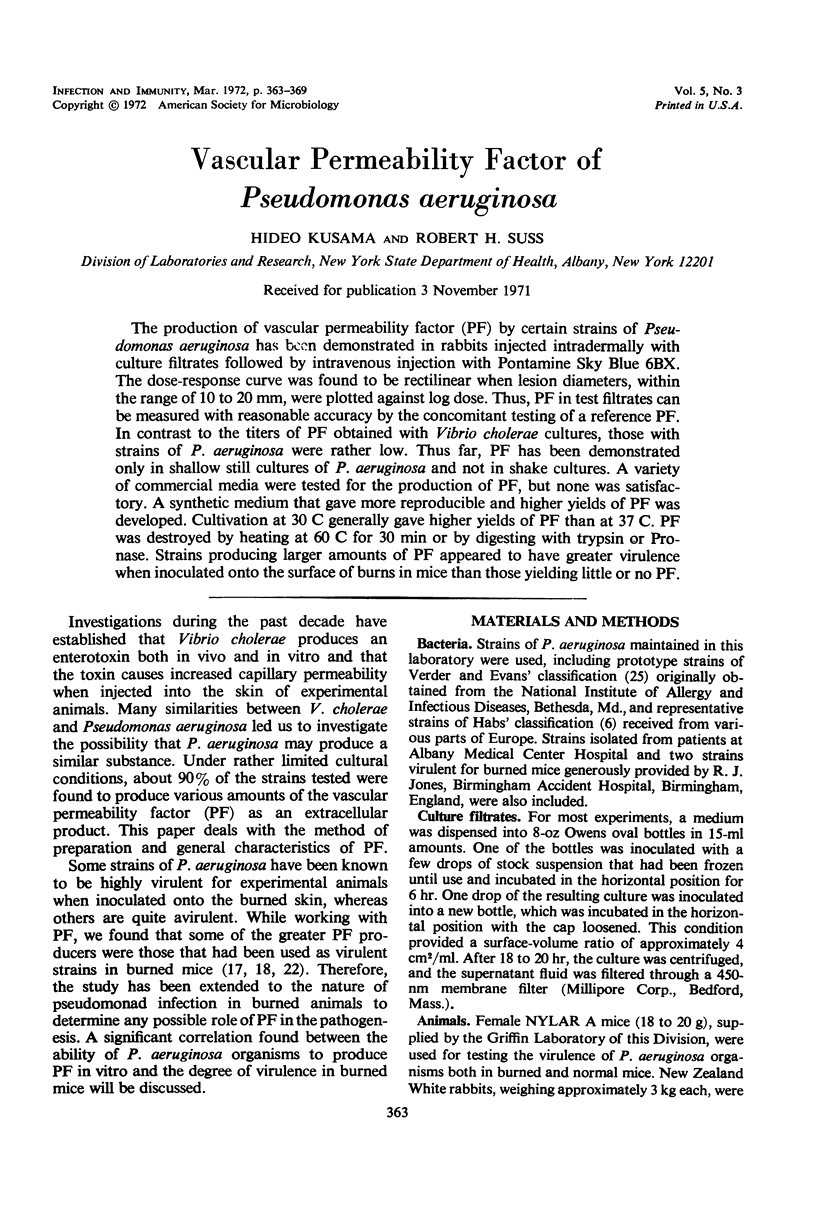
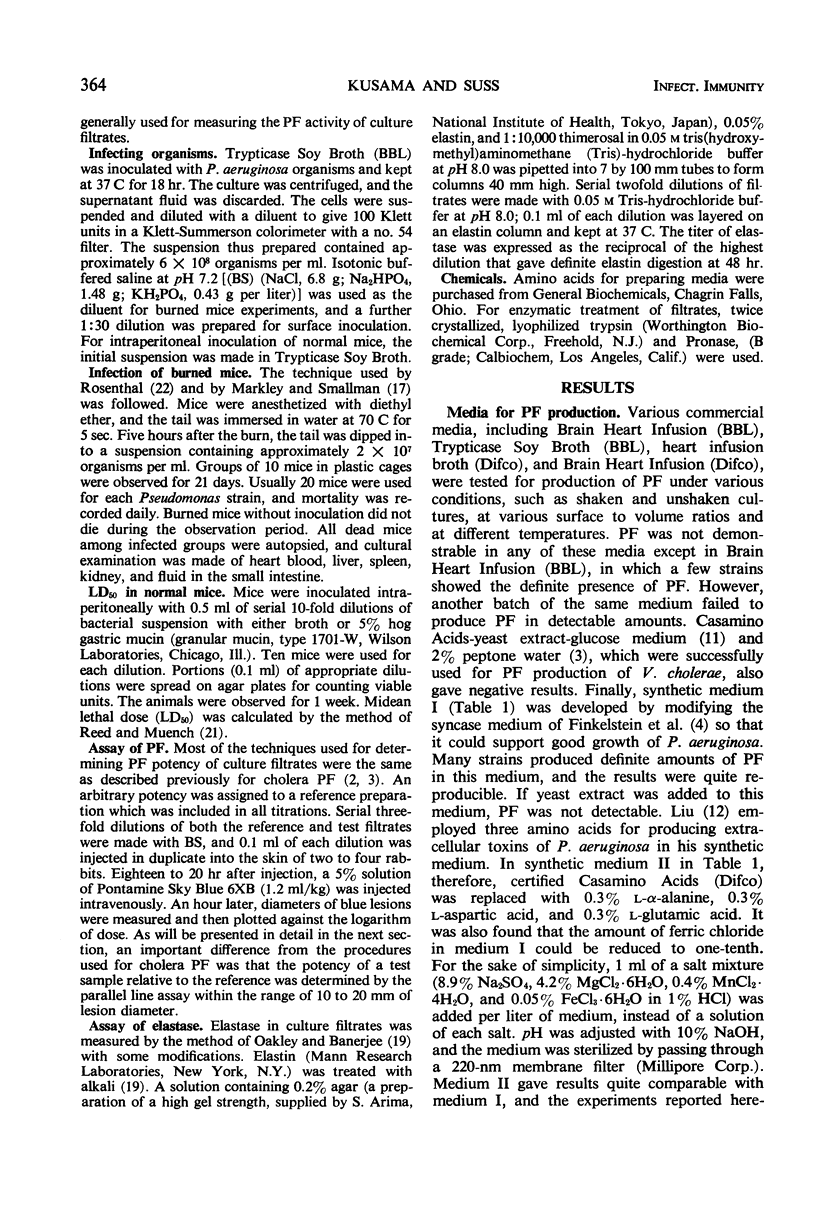

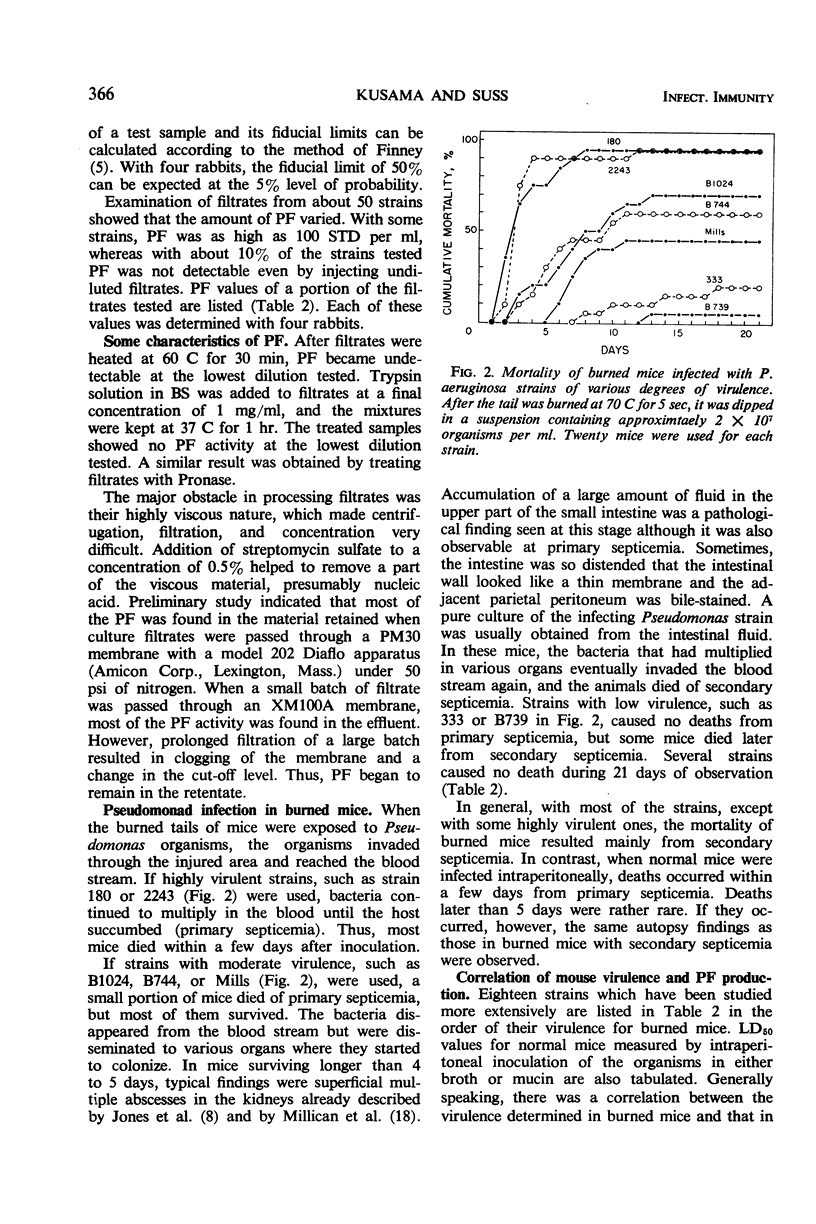

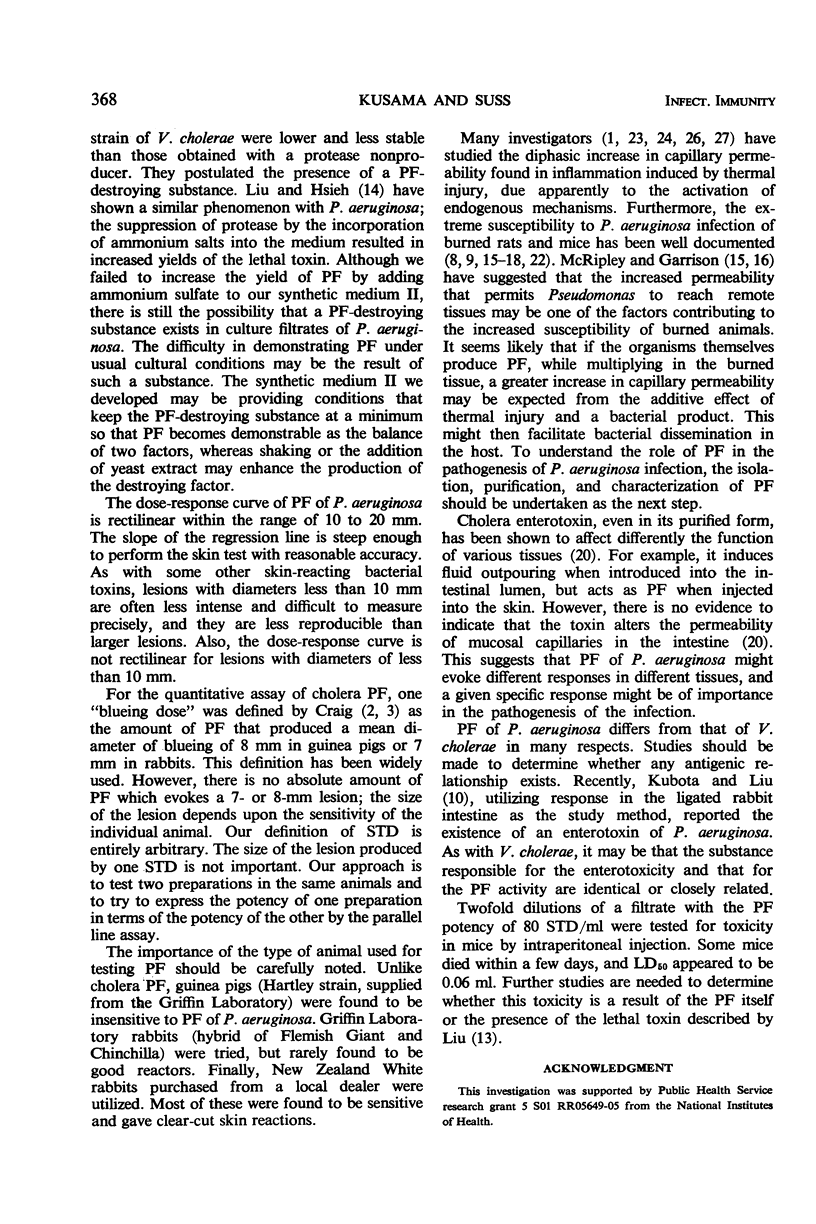
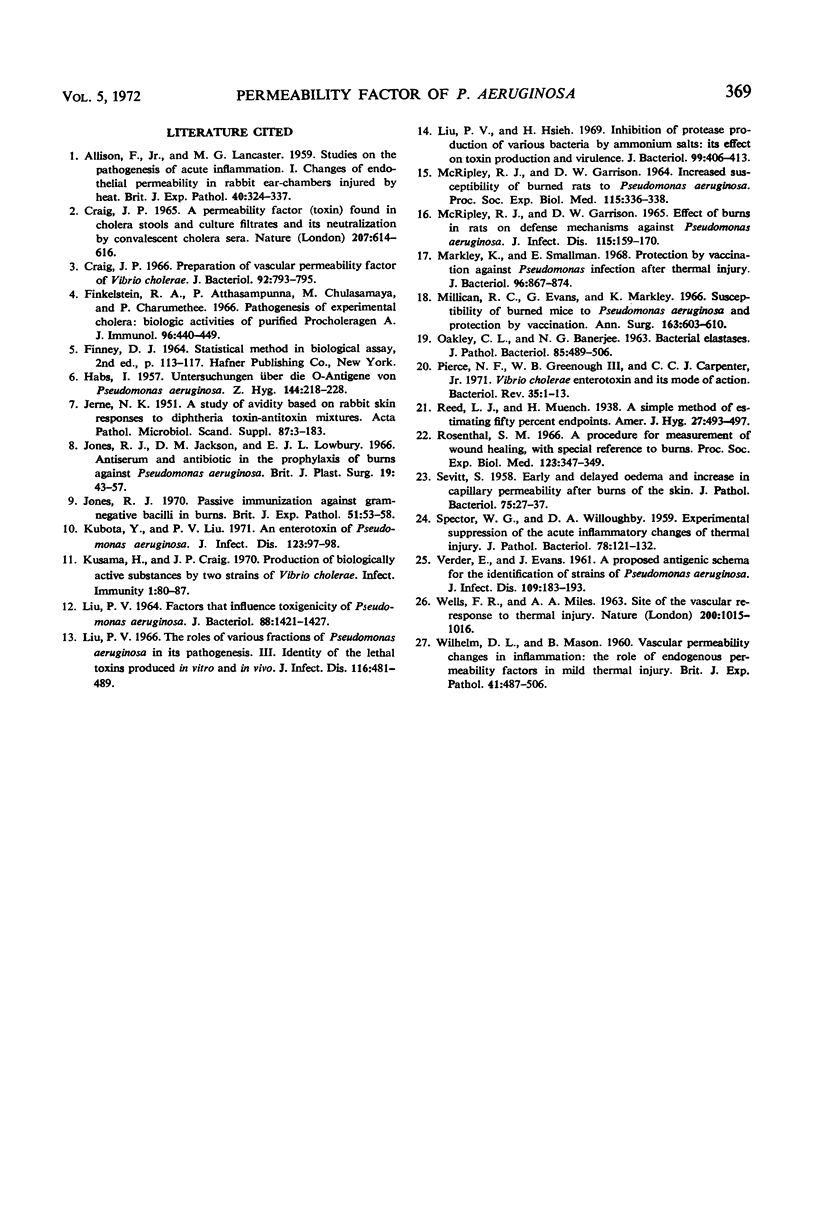
Selected References
These references are in PubMed. This may not be the complete list of references from this article.
- ALLISON F., Jr, LANCASTER M. G. Studies on the pathogenesis of acute inflammation. I. Changes of endothelial permeability in rabbit ear-chambers injured by heat. Br J Exp Pathol. 1959 Aug;40:324–337. [PMC free article] [PubMed] [Google Scholar]
- Craig J. P. A permeability factor (toxin) found in cholera stools and culture filtrates and its neutralization by convalescent cholera sera. Nature. 1965 Aug 7;207(997):614–616. doi: 10.1038/207614a0. [DOI] [PubMed] [Google Scholar]
- Craig J. P. Preparation of the vascular permeability factor of Vibrio cholerae. J Bacteriol. 1966 Sep;92(3):793–795. doi: 10.1128/jb.92.3.793-795.1966. [DOI] [PMC free article] [PubMed] [Google Scholar]
- Finkelstein R. A., Atthasampunna P., Chulasamaya M., Charunmethee P. Pathogenesis of experimental cholera: biologic ativities of purified procholeragen A. J Immunol. 1966 Mar;96(3):440–449. [PubMed] [Google Scholar]
- HABS I. Untersuchungen über die O-Antigene von Pseudomonas aeruginosa. Z Hyg Infektionskr. 1957;144(3):218–228. [PubMed] [Google Scholar]
- JERNE N. K. A study of avidity based on rabbit skin responses to diphtheria toxin-antitoxin mixtures. Acta Pathol Microbiol Scand Suppl. 1951;87:1–183. [PubMed] [Google Scholar]
- Jones R. J., Jackson D. M., Lowbury E. J. Antiserum and antibiotic in the prophylaxis of burns against Pseudomonas aeruginosa. Br J Plast Surg. 1966 Jan;19(1):43–57. doi: 10.1016/s0007-1226(66)80007-3. [DOI] [PubMed] [Google Scholar]
- Jones R. J. Passive immunisation against Gram-negative bacilli in burns. Br J Exp Pathol. 1970 Feb;51(1):53–58. [PMC free article] [PubMed] [Google Scholar]
- Kubota Y., Liu P. V. An enterotoxin of Pseudomonas aeruginosa. J Infect Dis. 1971 Jan;123(1):97–98. doi: 10.1093/infdis/123.1.97. [DOI] [PubMed] [Google Scholar]
- Kusama H., Craig J. P. Production of Biologically Active Substances by Two Strains of Vibrio cholerae. Infect Immun. 1970 Jan;1(1):80–87. doi: 10.1128/iai.1.1.80-87.1970. [DOI] [PMC free article] [PubMed] [Google Scholar]
- LIU P. V. FACTORS THAT INFLUENCE TOXIGENICITY OF PSEUDOMONAS AERUGINOSA. J Bacteriol. 1964 Nov;88:1421–1427. doi: 10.1128/jb.88.5.1421-1427.1964. [DOI] [PMC free article] [PubMed] [Google Scholar]
- Liu P. V., Hsieh H. C. Inhibition of protease production of various bacteria by ammonium salts: its effect on toxin production and virulence. J Bacteriol. 1969 Aug;99(2):406–413. doi: 10.1128/jb.99.2.406-413.1969. [DOI] [PMC free article] [PubMed] [Google Scholar]
- Liu P. V. The roles of various fractions of Pseudomonas aeruginosa in its pathogenesis. 3. Identity of the lethal toxins produced in vitro and in vivo. J Infect Dis. 1966 Oct;116(4):481–489. doi: 10.1093/infdis/116.4.481. [DOI] [PubMed] [Google Scholar]
- MCRIPLEY R. J., GARRISON D. W. EFFECT OF BURNS IN RATS ON DEFENSE MECHANISMS AGAINST PSEUDOMONAS AERUGINOSA. J Infect Dis. 1965 Apr;115:159–170. doi: 10.1093/infdis/115.2.159. [DOI] [PubMed] [Google Scholar]
- MCRIPLEY R. J., GARRISON D. W. INCREASED SUSCEPTIBILITY OF BURNED RATS TO PSEUDOMONAS AERUGINOSA. Proc Soc Exp Biol Med. 1964 Feb;115:336–338. doi: 10.3181/00379727-115-28906. [DOI] [PubMed] [Google Scholar]
- Markley K., Smallman E. Protection by vaccination against Pseudomonas infection after thermal injury. J Bacteriol. 1968 Oct;96(4):867–874. doi: 10.1128/jb.96.4.867-874.1968. [DOI] [PMC free article] [PubMed] [Google Scholar]
- Millican R. C., Evans G., Markley K. Susceptibility of burned mice to Pseudomonas aeruginosa and protection by vaccination. Ann Surg. 1966 Apr;163(4):603–610. doi: 10.1097/00000658-196604000-00014. [DOI] [PMC free article] [PubMed] [Google Scholar]
- OAKLEY C. L., BANERJEE N. G. Bacterial elastases. J Pathol Bacteriol. 1963 Apr;85:489–506. [PubMed] [Google Scholar]
- Pierce N. F., Greenough W. B., 3rd, Carpenter C. C., Jr Vibrio cholerae enterotoxin and its mode of action. Bacteriol Rev. 1971 Mar;35(1):1–13. doi: 10.1128/br.35.1.1-13.1971. [DOI] [PMC free article] [PubMed] [Google Scholar]
- Rosenthal S. M. A procedure for measurement of wound healing, with special reference to burns. Proc Soc Exp Biol Med. 1966 Nov;123(2):347–349. doi: 10.3181/00379727-123-31484. [DOI] [PubMed] [Google Scholar]
- SEVITT S. Early and delayed oedema and increase in capillary permeability after burns of the skin. J Pathol Bacteriol. 1958 Jan;75(1):27–37. doi: 10.1002/path.1700750105. [DOI] [PubMed] [Google Scholar]
- SPECTOR W. G., WILLOUGHBY D. A. Experimental suppression of the acute inflammatory changes of thermal injury. J Pathol Bacteriol. 1959 Jul;78:121–132. doi: 10.1002/path.1700780113. [DOI] [PubMed] [Google Scholar]
- VERDER E., EVANS J. A proposed antigenic schema for the identification of strains of Pseudomonas aeruginosa. J Infect Dis. 1961 Sep-Oct;109:183–193. doi: 10.1093/infdis/109.2.183. [DOI] [PubMed] [Google Scholar]
- WELLS F. R., MILES A. A. SITE OF THE VASCULAR RESPONSE TO THERMAL INJURY. Nature. 1963 Dec 7;200:1015–1016. doi: 10.1038/2001015a0. [DOI] [PubMed] [Google Scholar]
- WILHELM D. L., MASON B. Vascular permeability changes in inflammation: the role of endogenous permeability factors in mild thermal injury. Br J Exp Pathol. 1960 Oct;41:487–506. [PMC free article] [PubMed] [Google Scholar]


